The evolution of Filipino hip-hop spans decades, from its roots in the 1980s to its modern-day explosion. This genre has been shaped by African-American and Latino cultures, which Filipino youth have adapted and infused with local languages, folklore, and slang.
Early hip-hop addressed social issues through creative storytelling. Breakthrough albums, such as those by Francis Magalona, tackled topics like poverty and inequality, paving the way for future generations of rappers. These artists challenged societal norms, using their music as a powerful platform for self-expression and social commentary.
Today, Filipino hip-hop continues to grow and evolve. Emerging artists bring fresh perspectives, expanding the global presence of Filipino hip-hop. Rappers like Gloc-9 and Abra have gained international recognition, showcasing the genre’s diversity and creativity.
Early Influences and Beginnings
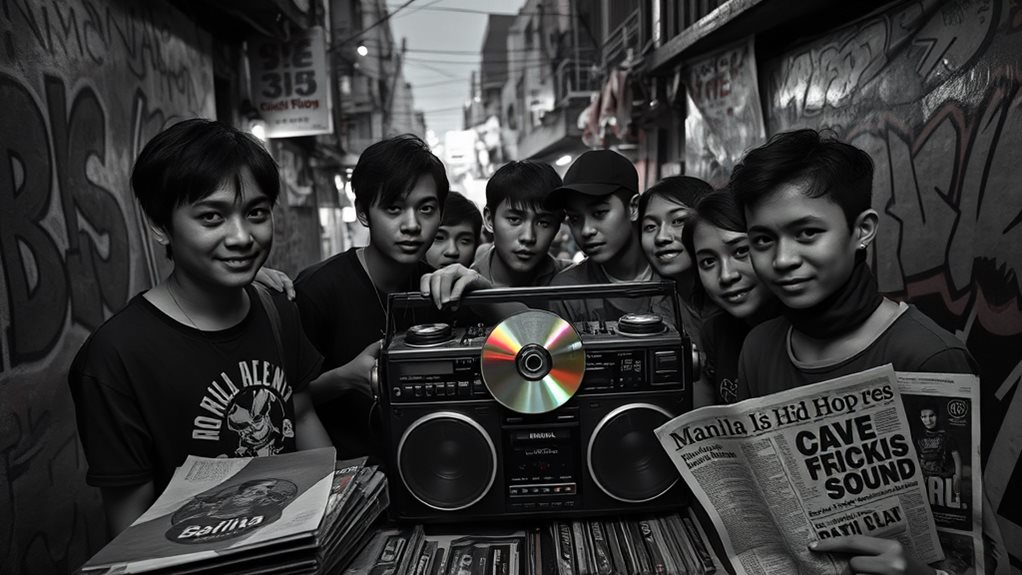
Filipino youth were introduced to hip-hop culture in the 1980s through American military bases in the Philippines. These bases, such as Clark Air Base and Subic Bay Naval Base, served as hubs for cultural exchange between African-American, Filipino-American, and Latino servicemen and the local population.
The influence of African-American artists like DJ Hollywood and Grandmaster Flash, played a significant role in shaping the early sound of Filipino hip-hop.
The early pioneers of Filipino hip-hop were followed by the rise of mobile DJ crews and local breakdancing groups. These crews and groups further amplified the cultural exchange between American and Filipino youth.
By the early 1980s, Filipino youth had already been exposed to American disco. Local clubs that catered to both Filipino and international crowds played a significant role in introducing American disco to the Filipino youth.
Rise of Local Breakdancing and Rap
Breakdancing and rap in the Philippines emerged due to American military base influence and early hip-hop adopters.
The Golden Age of Manila Sound
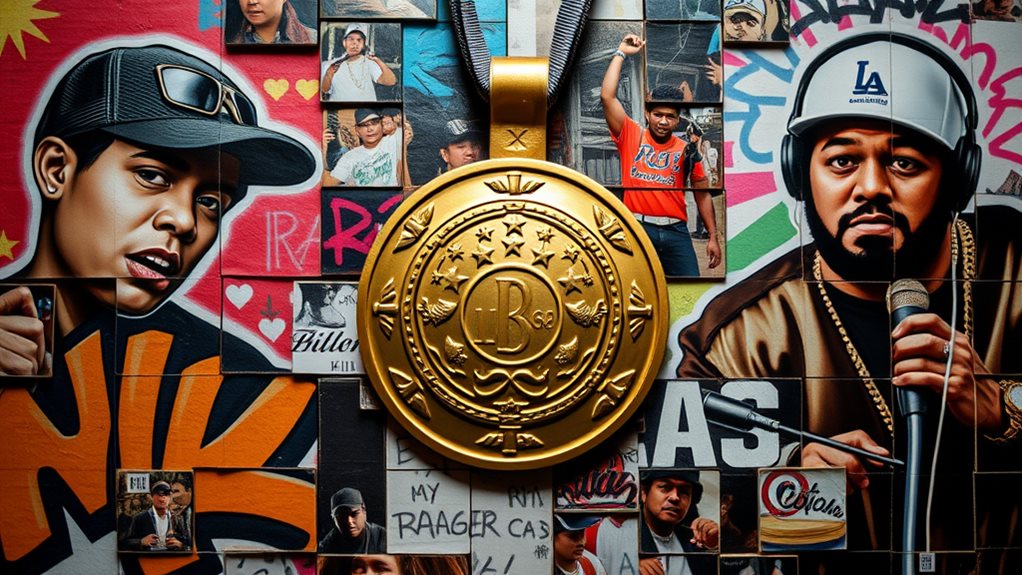
Manila Sound: A Fusion of International Styles and Filipino Sensibilities
Manila Sound emerged in the mid-1970s in Metro Manila, born from the cultural and social change of the decade. Cultural changes in the Philippines, driven by Western influences through radio and the American military presence, played a significant role in shaping this unique sound.
Bands like Hotdog and Cinderella, known for songs like “Manila” and “Bato Sa Buhangin,” and VST & Company for hits like “Awitin Mo at Isasayaw Ko,” are icons of this golden age of Manila Sound.
The legacy of Manila Sound can be heard in Filipino popular culture today, as it paved the way for the development of Original Pilipino Music (OPM).
Recent artists pay homage to the classic Manila Sound by blending retro with modern elements. The essence of the past merges with the sensibilities of the present, making Manila Sound a significant influence on contemporary music.
Breakthrough Albums and Social Awareness
Breakthrough Albums and Social Awareness marked a pivotal moment in the evolution of Filipino hip-hop. Pioneering artists like Francis M, Bass Rhyme Posse, Andrew E, and others began to address pressing social issues in their lyrics, setting a new standard for the genre.
Francis M’s Early Experimentation Rap is Francis M” (1992) and Bass Rhyme Posse’s self-titled album (1991) are seminal works that tackled themes of drug addiction, corruption, and colonial mentality. These albums showcased raw and honest social commentary and critique, characteristic of the early days of Filipino hip-hop.
These breakthrough albums and artists taught us that hip-hop can be a powerful tool for social commentary and critique.
They challenged societal norms and expectations by addressing pressing issues and paving the way for future generations of Filipino rappers to explore and express their creativity and social consciousness.
Themes of Personal Life and Culture
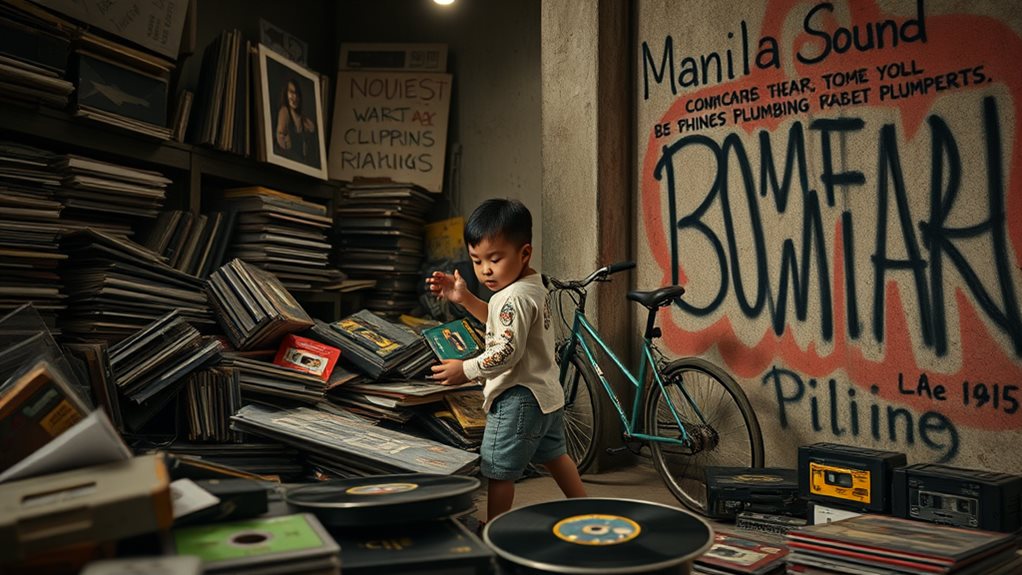
The evolution of Filipino hip-hop is reflected in its themes of personal life and culture. The intersection of personal identity and cultural heritage is a dominant force in the genre. Personal narratives are woven throughout their tracks, shedding light on the struggles and triumphs that shape their lives.
Evolution of Lyrics and Content
Filipino hip-hop has undergone a significant transformation in its lyrical scope, evolving from early [parody] and novelty to a distinctive genre rooted in personal narratives and socio-political commentary.
Early rap tracks addressed nationalistic themes and social issues, setting the stage for a more mature lyrical landscape. For instance, Francis Magalona’s “Rap Is Francis M” tackled drug addiction, political corruption, and colonial mentality, showcasing the genre’s capacity for socio-political commentary.
The entry of rap into the mainstream occurred with Francis Magalona’s debut album “Yo!” in 1990, marking a significant turning point in the genre’s trajectory.
The 1990s saw the rise of artists like Andrew E. and Michael V., who popularized humorous and sometimes problematic content.
The emergence of artists like Gloc-9 and Ez Mil further diversified the lyrical scope, tackling serious social and political issues.
Today, Filipino hip-hop continues to engage in social commentary, empowering Filipinos to protect their freedom.
With its rich thematic diversity, the genre has solidified its position as a significant voice in contemporary Philippine culture.
The Rise of Rap Battles and Platforms
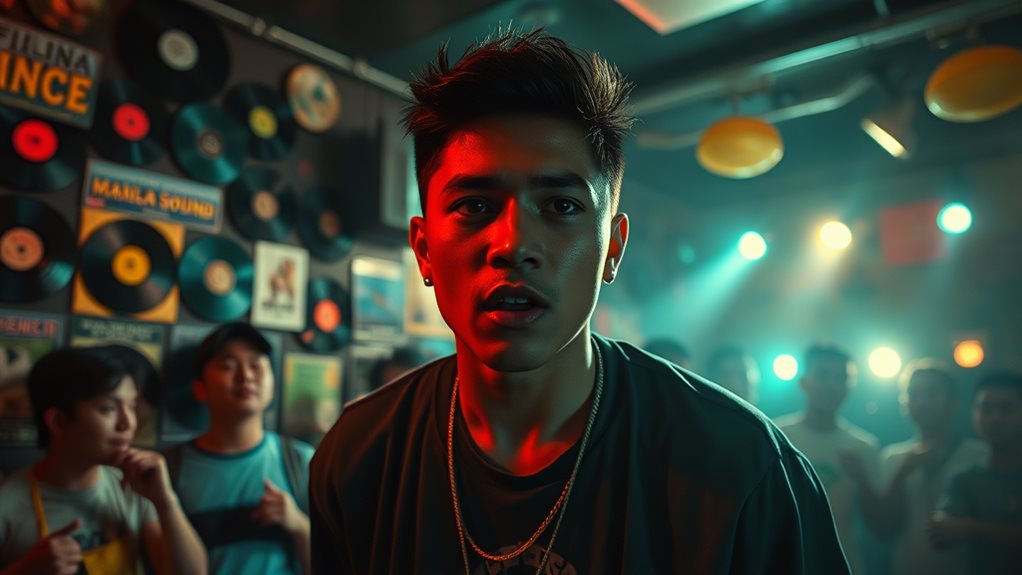
FlipTop Battle League: A Cornerstone of Contemporary Philippine Rap****
With millions of subscribers and billions of views, FlipTop Battle League has become a cornerstone of contemporary Philippine rap, catapulting the genre to unprecedented heights. This platform has created a new ecosystem for creatives to showcase their skills, with FlipTop’s battle league being a pioneering force in the Pinoy battle rap scene.
Fusion of Traditional and Modern Rap
The league combines traditional Balagtasan, a poetry-based debating approach, with modern freestyle rap battles. The judging criteria, which include creativity, verses, and audience appeal, set a high standard for participants to strive for.
This fusion has led to a surge in innovative content, with local and international collaborations further boosting the global reach of Filipino hip-hop.
Increased Exposure of Contemporary Rap Music
Thanks to platforms like YouTube and social media, fans are benefiting from the increased exposure of contemporary rap music. The evolution of rap battles and platforms has opened doors for talented artists to showcase their work, pushing the genre to new heights.
Talented artists can now showcase their work, and fans are embracing the changing landscape of Philippine hip-hop.
A Vibrant Community****
The rise of rap battles and platforms has created a vibrant community that’s embracing the changing landscape of Philippine hip-hop.
The community is excited to see where this creative journey will take us, with new talents emerging and collaborations pushing the genre forward.
Contemporary Scene and Battle Rap
The Philippine hip-hop scene has gained international recognition, characterized by its unique sound and vibrant culture.
Diverse Artists and Genres contribute to the scene’s growth. Filipino artists like Gloc-9 and regional groups such as Dice & K9 experiment with genres, creating a distinct sound.
Bilingual rapping reflects the language’s diversity, showcasing the artists’ versatility.
The scene features an array of talented artists, with 20 new talent showcases annually. Notably, 40% of artists perform rap, and 25% use trap as their primary rhythm.
Independent indie artists have achieved success through strong content, highlighting their creativity and skill.
Battle rap competitions, such as FlipTop, emphasize exceptional lyrical ability, encouraging artists to push their limits.
Collaborative performances between established and innovative artists inspire new styles, essential for the evolution of hip-hop and electronic dance music (EDM).
Influence of Filipino Culture and Identity
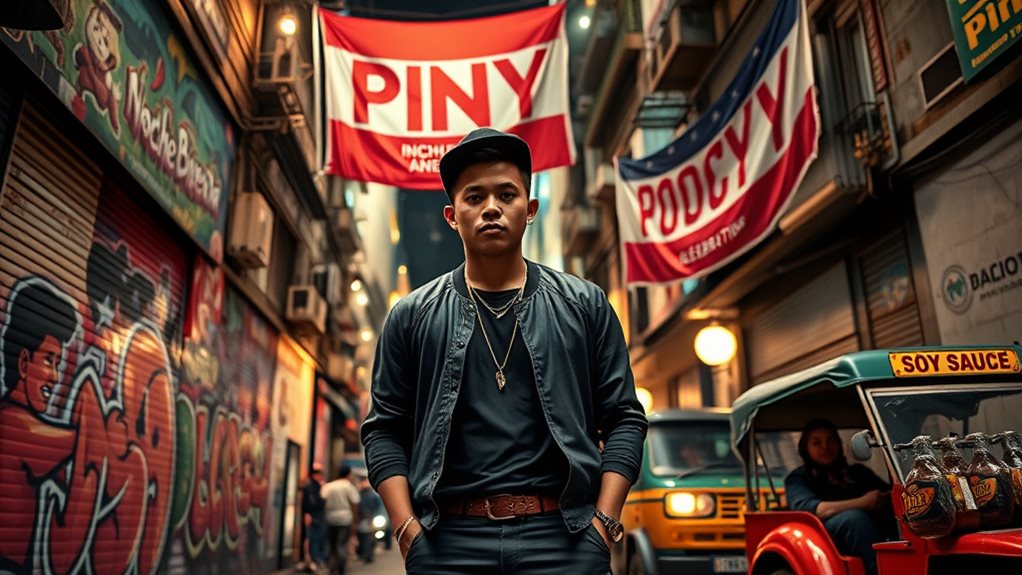
Rap music plays a vital role in expressing values and beliefs, empowering individuals to convey emotions through verbal expression.
This genre has become a powerful tool for identity representation, allowing artists to express themselves authentically. By sharing their experiences and perspectives, Filipino rappers contribute to a diverse storytelling landscape, enriching their society and engaging their audience.
Global Recognition and Diaspora Contributions
Rap music has become a powerful medium for Filipino artists to express their collective identity, sparking a cultural renaissance that has garnered international attention. Filipino artists are making a significant impact on the global hip-hop scene.
Rap has played a key role in promoting Philippine culture, with its incorporation of elements such as bahasa, Filipino folklore, and local slang.
Breaking into the Global Scene
One notable example is Shanti Dope’s “Amatz”, which was featured in Marvel’s Falcon and the Winter Soldier series, introducing the genre to a global audience.
Ez Mil’s collaboration with Eminem and Dr. Dre’s labels has cemented his status as a global phenomenon.
Furthermore, O Side Mafia’s historic achievement of reaching number one on the Billboard Philippines Songs Charts solidifies Filipino hip-hop’s presence in the international spotlight.
Blending Heritage with International Styles****
Filipino artists like Ez Mil, Apl.de.ap, and Cassie Ventura blend their Filipino heritage with international styles, creating a unique sound.
These trailblazers serve as role models for younger artists, inspiring them to pursue global recognition.
Their impact on the Filipino diaspora is profound, with local artists performing sold-out shows in the US and Canada, maintaining cultural ties and providing a sense of home.
Fusion of Traditional and Modern Sounds
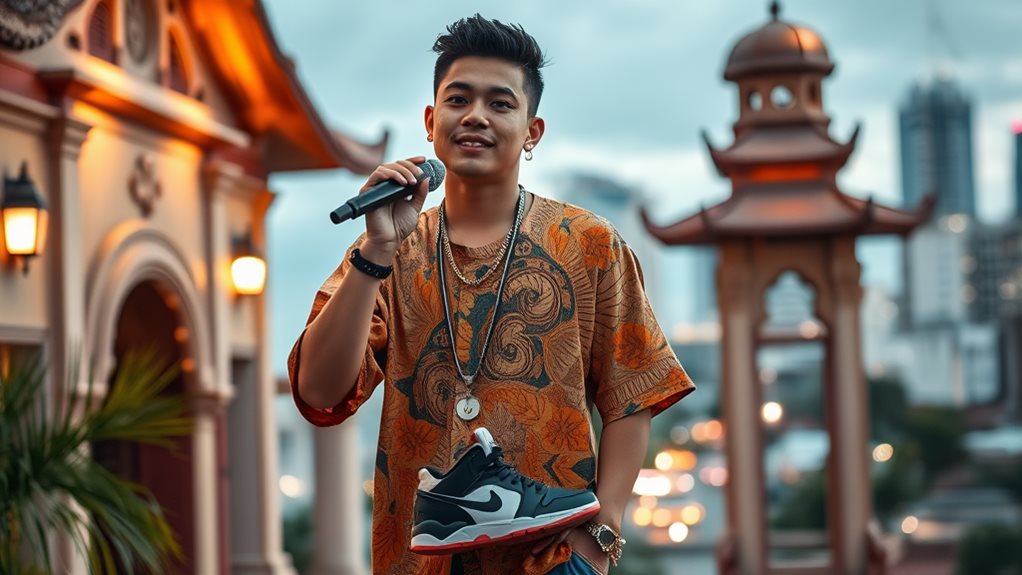
The Filipino hip-hop scene is distinct due to its integration of local languages and dialects. Artists incorporate Tagalog, Chavacano, and other Philippine languages into their rap lyrics, creating a relatable sound for the local audience. Filipino language use is a key aspect of the genre, with many artists drawing on their own experiences and cultural heritage. Rapasia’s debut album in 1991 and Francis M’s music addressed social and political issues through local languages, demonstrating the power of cultural fusion.
How Has the Evolution of OPM Influenced the Development of Filipino Hip-Hop?
Tracing the journey of opm music reveals its profound influence on Filipino hip-hop. As original Pilipino music evolved, it embraced diverse genres and cultural elements, paving the way for unique sounds in the hip-hop scene. This rich tapestry fosters creative expression, showcasing the dynamic identity of Filipino artists today.
Future Directions and Emerging Talent
Emerging artists are revolutionizing the genre with fresh perspectives and innovative styles, pushing the boundaries of music and contributing to the growth and diversification of the scene.
[They are breaking cultural barriers by collaborating with artists from different regions and backgrounds, showcasing the diversity and richness of Filipino culture.]
Emerging artists are using hip-hop as a platform for self-expression and identity through innovative storytelling. They are taking advantage of [global opportunities to share their music with a wider audience.]
Filipino hip-hop is gaining global recognition, paving the way for a global audience. Artists like Midnasty and Cookie$ are gaining traction in international markets, demonstrating the global appeal of Filipino hip-hop. This increased recognition is opening doors for Filipino artists to reach a broader audience.
As the scene continues to evolve, new talent and innovative collaborations are shaping the future of Filipino hip-hop.
Cultural collaborations are pushing the boundaries of music and contributing to the growth and diversification of the scene.
Questions and Answers
What Percentage of Filipino Hip-Hop Artists Have Been Signed to Major Record Labels?
A small percentage of Filipino hip-hop artists have been signed to major record labels. For instance, Zack Tabudlo and Moira Dela Torre have been signed to UMG Philippines, while Deny and the Tu$ Brother$ have been signed to Def Jam Philippines.
How Many Students Have Received Scholarships for Studying Music in the Philippines?
Around 5,000 students in the Philippines receive scholarships for music education every year. These scholarships are offered by various institutions and organizations, providing grants, awards, and full-ride scholarships to support access to music education.
Are There Any Notable Filipino Hip-Hop Artists With Ties to the Mainstream Music Industry?
Filipino hip-hop artists have successfully collaborated with the mainstream music industry.
Notable artists like Ez Mil, Shanti Dope, and Loonie have gained international recognition, bridging cultural gaps through their music. This has marked a significant impact, demonstrating the growing influence of Filipino hip-hop globally.
What Percentage of Filipino Rap Lyrics Address Social and Environmental Issues?
About 80% of Filipino rap lyrics tackle social and environmental issues. These issues include the drug war, air pollution, and other pressing concerns that affect the Filipino community. Through lyrical themes and social commentary, many Filipino rap artists provide nuanced insights into these problems, offering a unique perspective on the country’s challenges.
How Many Filipino Hip-Hop Artists Have Performed at International Music Festivals?
Several Filipino hip-hop artists have performed at international music festivals. These artists have shared the stage with global talents at festivals like Axean Music Festival in Bali and Rolling Loud Thailand. Tunecore’s international collaborations and festival performances have made this possible.